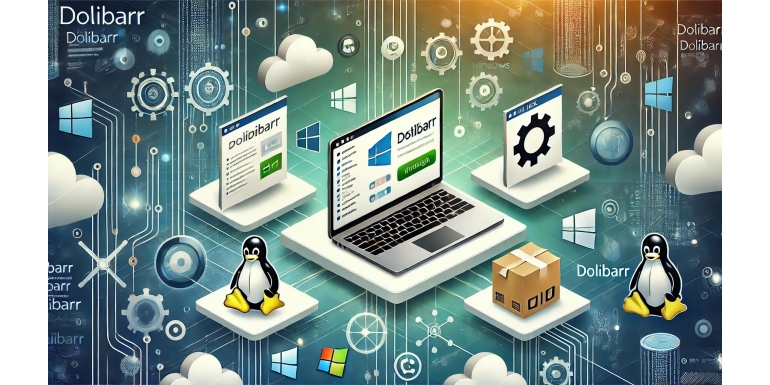
Introduction
Dolibarr is a powerful and flexible open-source ERP/CRM software, ideal for small and medium-sized businesses. It allows managing clients, inventory, invoicing, and many other aspects of a business. However, its installation may vary depending on the operating system used.
In this article, we will explain the best practices for installing Dolibarr on Windows, Linux, and macOS to ensure optimal configuration and smooth operation.
1. General Prerequisites for Installing Dolibarr
Before proceeding with the installation, it is essential to ensure that your system meets the following prerequisites:
-
Web server: Apache, Nginx, or any other compatible server
-
Database: MySQL or MariaDB
-
Programming language: PHP (minimum recommended version 7.4)
-
PHP extensions: pdo_mysql, gd, curl, json, session, zip, etc.
-
Disk space: Minimum 500 MB
The installation of these prerequisites varies depending on the operating system used. We will now detail the installation steps for each platform.
2. Installing Dolibarr on Windows
Windows is widely used by businesses, and installing Dolibarr on this platform can be done in several ways.
2.1. Installation via the Official Windows Installer
-
Download the installer from the official Dolibarr website.
-
Run the installer and follow the instructions.
-
Choose an installation directory (default: C:\Dolibarr).
-
Configure the web server: The installer includes Apache, MySQL, and PHP.
-
Complete the installation and access Dolibarr via
http://localhost/dolibarr/.
2.2. Manual Installation with WAMP/XAMPP
If you want more control, use WAMP or XAMPP:
-
Install WAMP/XAMPP and verify that Apache, MySQL, and PHP are working.
-
Download Dolibarr (zip version) and extract it into the
wwworhtdocsfolder. -
Create a database via phpMyAdmin.
-
Access the installer via
http://localhost/dolibarr/install/and follow the steps.
3. Installing Dolibarr on Linux
Linux is often preferred for servers due to its stability and security.
3.1. Installation via Package Manager
On Debian/Ubuntu, use:
sudo apt update && sudo apt install apache2 mysql-server php php-mysqlThen install Dolibarr:
sudo apt install dolibarrThen access Dolibarr via http://localhost/dolibarr/.
3.2. Manual Installation
If you want a more customized installation:
-
Download Dolibarr and extract it into
/var/www/html/. -
Configure Apache/Nginx: Create a vhost for Dolibarr.
-
Assign the correct permissions:
sudo chown -R www-data:www-data /var/www/html/dolibarr-
Access the installer and follow the steps.
4. Installing Dolibarr on macOS
macOS, being a UNIX system, follows a similar approach to Linux.
4.1. Using Homebrew
-
Install Apache, MySQL, and PHP with Homebrew:
brew install httpd mysql php-
Download and extract Dolibarr into
/usr/local/var/www/. -
Configure Apache and restart the service.
-
Access
http://localhost/dolibarr/install/.
4.2. Using MAMP
MAMP allows for an easier installation:
-
Install MAMP and verify that the services are running.
-
Extract Dolibarr into
htdocs. -
Create a database via phpMyAdmin.
-
Start the installation via the browser.
5. Optimization and Post-Installation Configuration
After installation, here are some best practices to optimize Dolibarr:
-
Secure the database: Change default passwords.
-
Set up an SSL certificate for secure connections.
-
Optimize Apache/Nginx for better performance.
-
Automate backups with cron scripts.
Conclusion
Installing Dolibarr may seem complex, but by following these best practices, you ensure a stable and high-performance installation. Whether on Windows, Linux, or macOS, each system offers solutions adapted to your needs.
With this optimal configuration, you will be able to fully exploit Dolibarr's capabilities and improve your business management.
